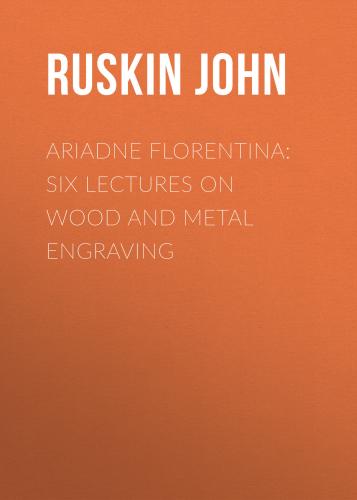Fig. 1
77. Since, then, in wood printing, you print from the surface left solid; and, in metal printing, from the hollows cut into it, it follows that if you put few touches on wood, you draw, as on a slate, with white lines, leaving a quantity of black; but if you put few touches on metal, you draw with black lines, leaving a quantity of white.
Now the eye is not in the least offended by quantity of white, but is, or ought to be, greatly saddened and offended by quantity of black. Hence it follows that you must never put little work on wood. You must not sketch upon it. You may sketch on metal as much as you please.
78. "Paradox," you will say, as usual. "Are not all our journals,—and the best of them, Punch, par excellence,—full of the most brilliantly swift and slight sketches, engraved on wood; while line-engravings take ten years to produce, and cost ten guineas each when they are done?"
Yes, that is so; but observe, in the first place, what appears to you a sketch on wood is not so at all, but a most laborious and careful imitation of a sketch on paper; whereas when you see what appears to be a sketch on metal, it is one. And in the second place, so far as the popular fashion is contrary to this natural method,—so far as we do in reality try to produce effects of sketching in wood, and of finish in metal,—our work is wrong.
Those apparently careless and free sketches on the wood ought to have been stern and deliberate; those exquisitely toned and finished engravings on metal ought to have looked, instead, like free ink sketches on white paper. That is the theorem which I propose to you for consideration, and which, in the two branches of its assertion, I hope to prove to you; the first part of it, (that wood-cutting should be careful,) in this present lecture; the second, (that metal-cutting should be, at least in a far greater degree than it is now, slight, and free,) in the following one.
Конец ознакомительного фрагмента.
Текст предоставлен ООО «ЛитРес».
Прочитайте эту книгу целиком, купив полную легальную версию на ЛитРес.
Безопасно оплатить книгу можно банковской картой Visa, MasterCard, Maestro, со счета мобильного телефона, с платежного терминала, в салоне МТС или Связной, через PayPal, WebMoney, Яндекс.Деньги, QIWI Кошелек, бонусными картами или другим удобным Вам способом.
